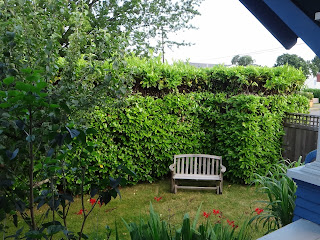Love your neighbor, yet pull not down your hedge.
George Herbert
A little garden sanctuary in the city comes at a price, and every summer for the past 30 years, finding someone to "cut the hedge" looms up again as a troublesome and expensive project.
Are you thinking, and why not just do it yourself? Well, despite all the regular "trimming" old monster has been putting on height and girth since 1920. It's about 12 feet tall and 10 feet wide in places and not a job for an oldish lady balanced on a ladder with a slicing power tool. The mass of clippings is far beyond the capacity of our clean and green recycle bin. That means expensive trips to the dreaded urban "dump." So...this gardener's task is to find a new professional hedge trimmer (almost) every year.
They all seem to hate their work and go out of business regularly. That guy you used last year who was pretty good? His phone has been disconnected. No one picks up the phone anyway, and after the usual tag you finally manage to get a fellow to drop by for an estimate. There are heavy sighs and gloomy looks when he gives you the unpleasantly high bid. At least
that part no longer comes as a surprise after all these years. You watch him shaking his head and you feel guilty just owning such a hedge and causing so much trouble to the poor trimmer!
John and I were reminiscing the other day about the memorable characters
The Laurel has brought into our lives:
1. A pothead who cut himself with his tools, and then got into a rock fight with kids in front of the house and had his tooth knocked out. (He didn't have a dentist of course, and I sent him up the street to mine for an emergency visit.)
2. A guy who asked for a $200 advance to "rent tools" and never came back. We called his home phone and his dad said, "good luck on that." A few months later, I saw him passed out in his pick-up behind the Safeway. (No, I did not knock on the window and demand my money.)
3. A "born-again" hedge cutter, who banged on the door every few minutes needing support, praise, encouragement, ice water, help and guidance. He complained constantly. He talked more than he worked. He slept late and worked late, so the neighborhood roared with power tolls until 11pm. There were complaints.
4. Mr. Nguyen and his wife. Let's just say, a language barrier.
5. And then there was Geraldo, my hero. Uncomplaining, capable, tireless, and self-sufficient. A Gary Cooper of hedge cutters! He did beautiful work for 2 years and then went back to Mexico to help his old mother-- go figure. Just looking at his picture still makes me sad.
 |
| Saint Geraldo of the Hedge |
So, who could blame me being excited about finding Jason this year? A real certified arborist with a local business specializing in renovating old hedges. We watched him do a fine job on the hedge across the street. He came over for a quick look at ours and said it would be no problem (for over twice what we paid last year, that is) to trim it up and even take the top down 3 or 4 feet. Which sounded like a terrific idea. Finally, some control of the beast.
Three weeks later he got started. He slashed a line, he cut out a big gap in the top. From the house, it looked like he knew what he was doing. Then about 6:30, he silently left and sent a late email saying he could not complete the job as bid because the top of the hedge was too wide for him to reach across, ever. He could not trim the top, much less lower it. He added that no other trimmer in the city could do it either.
Well, this was a surprise to us, because even the alcoholics and complainers had been trimming the top for years. All he offered to do (for $450+ tax) was "taper" upper edge, so his gouging mistake would be less noticeable. Adios, Jason.
And here's the pretty sight I'll be looking at this morning while on the phone trying to find someone else. And wondering, if massive trees in Ohio (thanks Dan, for the pictures on
Casa de Terrible) can be sawed up and hauled off, surely the top of a hedge in Seattle can be mastered? And then there's always the
final solution: bulldozer. If the devil had a hedge, it would be a laurel.





















































